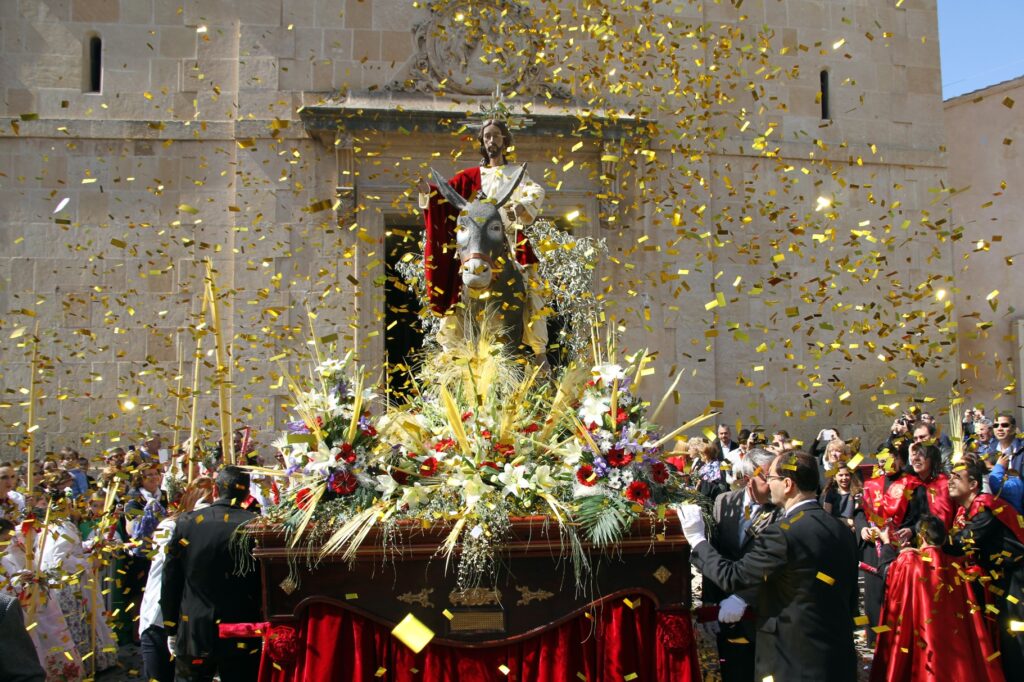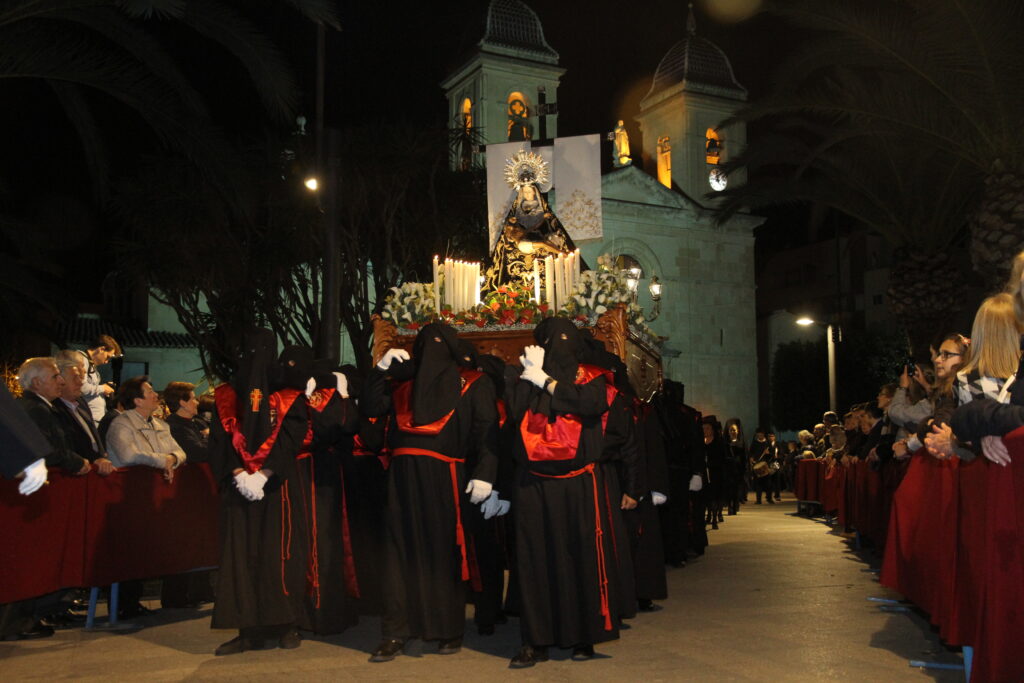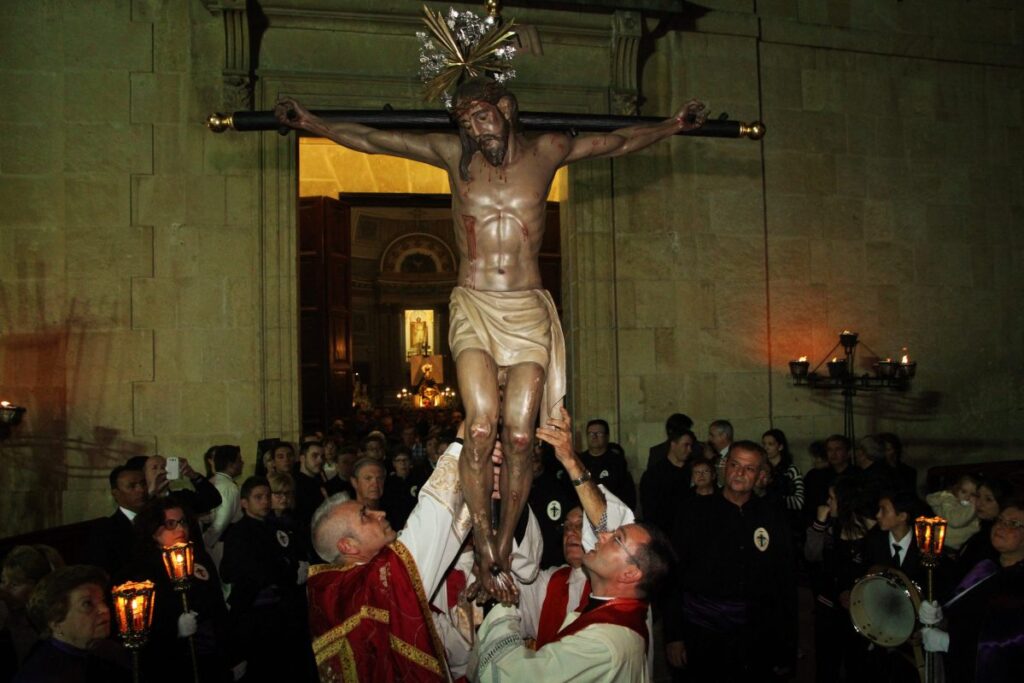Holy Week in Sant Joan
Easter Week in Sant Joan d’Alacant is one of the oldest known local celebrations, dating back to the 17th century. There are documents that show the popular devotion in the Good Friday Procession to the image of a Christ, probably the Christ of Peace, around 1637. In the 18th century, the existence of the images of Jesús Nazareno and the SantÃsima Virgen de la Soledad is confirmed, while in the 19th century there is information about the existence of the Virgen de Los Dolores and the Santo Sepulcro. It was in the 19th century, specifically in 1883, when the master Juan Goñi composed Los Siete Dolores de la Virgen, a unique polyphonic composition, which the people of Sant Joan have preserved to the present day.
In 1920, the image of Jesús Atado a la Columna (Jesus Tied to the Column) was added. The image of San Juan de la Palma also existed in those years. In the first decades of the 20th century, Holy Week consisted of various liturgical and devotional acts, among which the Canto de los Dolores was sung every day of the Septenario until Friday of Sorrows.


In 1936, almost all the images were destroyed during the Civil War (only the Virgen de la Soledad was saved) and it was in the 1940s when the Parish of San Juan Bautista renovated most of the missing carvings, to which it added new images such as Nuestra Señora de la Caridad (carved at the end of the 18th century).
In the second half of the 20th century, the spirit of relaunching Holy Week was reborn, processions were held again, traditions such as the Canto de los Dolores were revived and more confraternities were formed (Santa Mujer Verónica, in 1992, and Jesús Atado a la Columna and Nuestra Señora de los Dolores, in 2007).
The creation in 1981 of the Board of Brotherhoods (current Board of Brotherhoods and Brotherhoods of Holy Week of Sant Joan d’Alacant) was the definitive support to lay the foundations of what today is the Holy Week of Sant Joan d’Alacant. . In those 80s, with the fundamental support of the parish priest D. Carmelo Dávila, the Board of Brotherhoods began to operate, with the objective of coordinating and organizing the Holy Week events. Since then, the events and celebrations were reinforced, recovering some old ones such as the song of Los Dolores, which was played again in 1997 and continues to this day.
Precisely, and in homage to D. Carmelo, in March 2015 the Casa de la Semana Santa ‘Carmelo Dávila’ was inaugurated, a municipal building where the Mayor Board keeps, preserves and protects all the religious heritage that the Holy Week of Sant Joan for centuries.
Currently, the Holy Week of Sant Joan d’Alacant has numerous events and celebrations, both cultural and religious. In the cultural part, the Presentation of the Announcing Book and Poster stands out (which has exceeded 25 editions), the Photography Exhibition of Holy Week in Spain (which is approaching 30 editions), the Photography Contest (which has been held for seven years) and the Holy Week Proclamation.

In the liturgical part, the main events begin on Passion Saturday with the Song of Sorrows. At the end of the ceremony, following tradition, the musicians and singers receive a dozen eggs, and the priests, two dozen. The next day, Palm Sunday, the procession is celebrated with the image of Jesus Triumphant and the palms and branches are blessed in the Plaza de la Constitución. On Holy Tuesday the Procession of Silence takes place with the images of Jesus Tied to the Column and the Virgin of Sorrows, in an atmosphere of meditation.
On Holy Thursday in the afternoon, the Last Supper mass is celebrated and later, the transfer is made to the Monument in the Chapel of Christ, decorated with palms, olive branches and a tapestry. At night a Via Crucis takes place through the town. The Holy Friday In the afternoon the Services are celebrated in the church, and then the procession of the Holy Burial takes place, in which the images of the Nazarene, the Veronica, the Sorrowful, the Holy Christ of Peace, the Charity, the Holy Sepulcher, participate. a Guiding Cross and Solitude. At the end of the procession, the blessing with the image of the Holy Christ of Peace takes place at the door of the church, just like on September 14.
On Holy Saturday night the Easter Vigil takes place in the church with the renewal of fire and water, and finally on Easter Sunday the Procession of the Encounter with the Virgin of Sorrows and the Blessed Sacrament under a canopy is celebrated. At the moment of the Meeting, the bells ring loudly, rockets are launched and hundreds of colorful hallelujahs invade the sky. Then, the black veil that covers the Virgin’s face is removed as a sign of mourning, which is replaced by a white rose as a symbol of the resurrection. This marks the end of Holy Week. The face of the Virgin is removed as a sign of mourning, which is replaced by a white rose as a symbol of the resurrection.
Did you know that...?
At the beginning of the 20th century, Palm Sunday opened Holy Week with the celebrations of this day. On Holy Thursday, after the celebration of mass in the morning, the Monument was placed on the main altar of the church. From that moment on, the bells stopped ringing and were replaced by the sounds of the rattle. At night the arrest of Jesus was represented in the Garden of Olives, preparing spaces such as the garden of the La Concepción estate for this purpose. After that, they returned to the church, and in front of the monument, a sermon was held. A group of men dressed as Roman soldiers participated in this event, as well as accompanying the procession escorting the image of the Holy Sepulchre.
The next day, Good Friday, the sermon of the Seven Words and the Offices was celebrated. The church was left in darkness to remember the death of Christ and the priests hit many elements and objects with clubs to create a noise, remembering the storm and earthquake that, according to tradition, followed the death of Christ. At dusk, the Good Friday prayer procession or ‘Caraputxos’ was celebrated with the aforementioned images, which started from the church and reached the hermitage of Benimagrell, which was presided over by the Holy Christ of the Peace that, under a canopy, closed the procession accompanied by hundreds of faithful crying out for mercy.
The next day, Holy or Glory Saturday, in the morning the Resurrection of Christ was celebrated. At ten in the morning with the ringing of bells, the moment was announced, and to celebrate it, people broke plates and ceramic objects, while many men from the field fired their shotguns in order to end the previous silence for the death of Christ. In addition, the water was blessed and everyone came with their jugs and pitchers to collect it.
Finally, on Easter Sunday, in the morning the Encounter procession was celebrated with the images of the Immaculate Conception and the Blessed Sacrament, which were in the Plaza Maisonnave. Once the procession was over, the day continued like every Sunday, with the usual market.
With the arrival of the Civil War, all the images that existed in the church were destroyed, and with them those that participated in the Holy Week celebrations. This forced new processional carvings to be made once the war was over. The first to be recovered, in March 1940, were those of the Santísimo Cristo de la Paz, made by the sculptor José María Ponsoda, and Jesús Nazareno, the work of Enrique Bellido. Shortly after, those of the Virgin of Sorrows and the Holy Sepulcher arrived. The Virgen de la Soledad, an image from the 19th century, was donated by a family who kept it in their home. Throughout the 20th century, the rest of the additions were made, such as the Virgin of Charity, a small image known as the ‘Xicoteta’, which was kept in a private home. In these years, all the brotherhoods were reorganized and refounded, each one in charge of taking care of its image.
Although during the two decades following the Civil War, the celebrations remained similar to those before the war. In the sixties there were many alterations, especially to the Good Friday procession. Due to pressure from many people who asked that the procession follow the logical order of events that occurred in the Passion, the Holy Christ stopped leaving at the end to do so between the Virgin of Sorrows and Charity, losing the main place of presidency that had since the origins of the procession. Another important event was the construction of the N-332, which demolished part of the Benimagrell neighborhood, making it impossible for the penitential route to reach there.
In 1993, the image of the Holy Woman Veronica was incorporated into the Good Friday procession, using a small image that was in the church until, in 1996, the new carving made by Valentín García Quinto was blessed. In the year 2000, the image of Jesus Triumphant was blessed, which participates every year in the Palm Sunday procession. The last addition was the image of Jesus Tied to the Column, in 2009.
